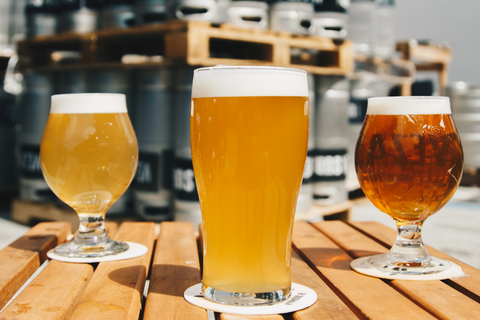Regardless of whether you are just starting out in the craft brewing world or if you are already a beer sapiens*, it is important for all of us to be clear about : What is beer made of?. This question seems to have a simple answer, but it's not that simple and we'll explain why.

In general, beer is an alcoholic beverage produced from sugars obtained from cereals and other grains, flavored and flavored with hops, which are then fermented in water with yeast, so the basis of the traditional production of a beer must contain 4 ingredients: water, malt, hops and yeast.
However, the brewing world is very creative, and between tests and the use of new ingredients many brewmasters reinvent themselves and launch authentic beers. But let's start by talking about the basic ingredients:
Water, more than 90% of the beer
It seems silly to highlight this ingredient, but many people when they pthink of beer do not remember how this component can be vital for our beers. Water represents more than 90% of the composition of beer and its quality is very important for the production process, that is, it must be filtered and chlorine-free

Many brands use water from local wells or from rivers in the mountains as a differential in the production of their beer, which seems fantastic to us from the perspective of using natural resources to produce craft beers and creating a connection between the brand and its region. On the other hand, from the point of view of flavor, this will hardly impact the final result, since in the end the water needs to go through a process to achieve a result that follows a quality pattern.
Malt, what makes beer beer
To begin with, we would like to point out that this is the ingredient that influences the colour, body and alcoholic strength of the beer. Some religiously say that this is the soul-ingredient of beer. Let's see, we know that malt is very, very important, but we have to clarify something: contrary to what many think, malt is not a cereal, is the result of subjecting a given cereal grain to a process called malting**.

The most widely used cereal grain in brewing is barley malt, because it is rich in sugars and low in protein. On the other hand, wheat, rye and oat malt are also widely used. During the roasting process of the grain, the aromas and flavors of the malt are defined, hence the notes of chocolate, coffee, biscuit, bread...well, an infinity of possibilities both in aroma and flavor.
Hops, the power of bitterness
This is the ingredient responsible for the intensity of the bitterness in beer. Humulus Lupulus (scientific name) is a climbing plant that it can reach up to 8 meters in height and only its female flowers can be used in the production of beers because they are rich in lupulin, an essential substance for the aromas and bitterness of beer. In addition, hops are a natural bactericide and fungicide, which helps preserve beer.

But there is no single type of hop, nooo...there are many varieties that provide different characteristics to the beer, we have hops of different nationalities (Australian, German, from the Czech Republic, North American, Japanese, etc.) and types: aroma hops, bitter hops and mixed hops. All this plurality helps to that the beers have aromas of passion fruit or flowers, flavor of manga or pineapple, there are endless possibilities!
Yeast, the true master brewer
Yeast is the fungus responsible for mixing the ingredients through fermentation, some brewmasters dare to admit that they “do not prepare beer”, what they do is “organize the environment for the yeasts to work. There are also different types of yeast: low fermentation (Lager yeast: Saccharomyces pastorianus), top fermentation (Ale yeast:
We hope you like this post, now that you know everything about the main ingredients of beer, we invite you to discover our selection of India Pale Ale style beers.
Cheers!,
*”sapiens” comes from Latin and means knowledge, and “beer” is beer in English; The union of the two defines a lifestyle for those who already have advanced brewing knowledge.
**Malting, simply put, is the controlled germination process of the grain (immersing it in water) that is interrupted by drying the grains from heat. The main objective of this process is to convert the starches present in the cereal into maltose, a type of sugar. In summary, it follows the following stages: selection, humidification, germination and drying/roasting.
.

